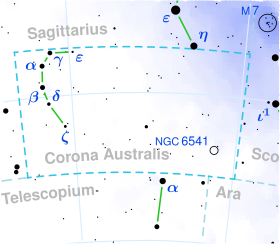Astronomy:HD 176425
| Observation data Epoch J2000.0 Equinox (celestial coordinates) | |
|---|---|
| Constellation | Corona Australis |
| Right ascension | 19h 02m 08.52100s[1] |
| Declination | −41° 54′ 37.8260″[1] |
| Apparent magnitude (V) | 6.21±0.01[2] |
| Characteristics | |
| Spectral type | A0 V[3] |
| B−V color index | 0.00[4] |
| Astrometry | |
| Radial velocity (Rv) | −12.8±4.3[5] km/s |
| Proper motion (μ) | RA: +30.557[1] mas/yr Dec.: −11.271[1] mas/yr |
| Parallax (π) | 9.1110 ± 0.0417[1] mas |
| Distance | 358 ± 2 ly (109.8 ± 0.5 pc) |
| Absolute magnitude (MV) | +0.75[6] |
| Details | |
| Mass | 2.63+0.38−0.30[7] M☉ |
| Radius | 2.19±0.11[8] R☉ |
| Luminosity | 50.8+0.6−0.7[1] L☉ |
| Surface gravity (log g) | 4.23+0.05−0.07[7] cgs |
| Temperature | 10,163[9] K |
| Metallicity [Fe/H] | −0.10[10] dex |
| Age | 286±7[11][12] Myr |
| Other designations | |
| Database references | |
| SIMBAD | data |
HD 176425, also known as HR 7177 or rarely 38 G. Coronae Australis, is a solitary, bluish-white hued star located in the southern constellation Corona Australis. It has an apparent magnitude of 6.21,[2] placing it near the limit for naked eye visibility, even under ideal conditions. Gaia DR3 parallax measurements imply a distance of 358 light-years,[1] and it is currently drifting closer with a heliocentric radial velocity of −12.8 km/s.[5] At its current distance, HD 176425's brightness is diminished by an interstellar extinction factor of 0.27 magnitudes[14] and it has an absolute magnitude of +0.75.[6]
HD 176425 is an ordinary A-type main-sequence star with a stellar classification of A0 V.[3] It has been used as an unpolarized standard in the southern sky.[15] It has 2.63 times the mass of the Sun[7] and 2.19 times the radius of the Sun.[8] The object radiates 50.8 times the luminosity of the Sun[1] from its photosphere at an effective temperature of 10,163 K.[9] HD 176425 is metal deficient with an iron abundance 79% that of the Sun ([Fe/H] = −0.10)[10] and it is estimated to be 286 million years old.[11][12]
References
- ↑ Jump up to: 1.0 1.1 1.2 1.3 1.4 1.5 1.6 Vallenari, A. et al. (2022). "Gaia Data Release 3. Summary of the content and survey properties". Astronomy & Astrophysics. doi:10.1051/0004-6361/202243940 Gaia DR3 record for this source at VizieR.
- ↑ Jump up to: 2.0 2.1 Høg, E.; Fabricius, C.; Makarov, V. V.; Urban, S.; Corbin, T.; Wycoff, G.; Bastian, U.; Schwekendiek, P. et al. (March 2000). "The Tycho-2 catalogue of the 2.5 million brightest stars". Astronomy and Astrophysics 355: L27–L30. ISSN 0004-6361. Bibcode: 2000A&A...355L..27H.
- ↑ Jump up to: 3.0 3.1 Houk, Nancy (1978). Michigan catalogue of two-dimensional spectral types for the HD stars: Declinations −53° to −40°. 2. Bibcode: 1978mcts.book.....H.
- ↑ Johnson, H. L.; Mitchell, R. I.; Iriarte, B.; Wisniewski, W. Z. (1966). "UBVRIJKL Photometry of the Bright Stars". Communications of the Lunar and Planetary Laboratory 4: 99–110. Bibcode: 1966CoLPL...4...99J.
- ↑ Jump up to: 5.0 5.1 Gontcharov, G. A. (November 2006). "Pulkovo Compilation of Radial Velocities for 35,495 Hipparcos stars in a common system". Astronomy Letters 32 (11): 759–771. doi:10.1134/S1063773706110065. ISSN 1063-7737. Bibcode: 2006AstL...32..759G.
- ↑ Jump up to: 6.0 6.1 Anderson, E.; Francis, Ch. (May 2012). "XHIP: An extended hipparcos compilation". Astronomy Letters 38 (5): 331–346. doi:10.1134/S1063773712050015. ISSN 1063-7737. Bibcode: 2012AstL...38..331A.
- ↑ Jump up to: 7.0 7.1 7.2 Stassun, Keivan G. et al. (9 September 2019). "The Revised TESS Input Catalog and Candidate Target List". The Astronomical Journal 158 (4): 138. doi:10.3847/1538-3881/ab3467. Bibcode: 2019AJ....158..138S.
- ↑ Jump up to: 8.0 8.1 Kervella, P.; Thévenin, F.; Di Folco, E.; Ségransan, D. (October 2004). "The angular sizes of dwarf stars and subgiants". Astronomy & Astrophysics 426 (1): 297–307. doi:10.1051/0004-6361:20035930. ISSN 0004-6361. Bibcode: 2004A&A...426..297K.
- ↑ Jump up to: 9.0 9.1 Westin, T. N. G. (April 1985). "The local system of early type stars. Spatial extent and kinematics.". Astronomy and Astrophysics Supplement Series 60: 99–134. ISSN 0365-0138. Bibcode: 1985A&AS...60...99W.
- ↑ Jump up to: 10.0 10.1 Anders, F. et al. (February 2022). "Photo-astrometric distances, extinctions, and astrophysical parameters for Gaia EDR3 stars brighter than G = 18.5". Astronomy & Astrophysics 658: A91. doi:10.1051/0004-6361/202142369. ISSN 0004-6361. Bibcode: 2022A&A...658A..91A.
- ↑ Jump up to: 11.0 11.1 Gontcharov, G. A. (November 2012). "Spatial distribution and kinematics of OB stars". Astronomy Letters 38 (11): 694–706. doi:10.1134/S1063773712110035. ISSN 1063-7737. Bibcode: 2012AstL...38..694G.
- ↑ Jump up to: 12.0 12.1 Gontcharov, G. A. (December 2012). "Dependence of kinematics on the age of stars in the solar neighborhood". Astronomy Letters 38 (12): 771–782. doi:10.1134/S1063773712120031. ISSN 1063-7737. Bibcode: 2012AstL...38..771G.
- ↑ "HD 176425". SIMBAD. Centre de données astronomiques de Strasbourg. http://simbad.u-strasbg.fr/simbad/sim-basic?Ident=HD+176425.
- ↑ Gontcharov, George A.; Mosenkov, Aleksandr V. (28 September 2017). "Verifying reddening and extinction for Gaia DR1 TGAS main sequence stars". Monthly Notices of the Royal Astronomical Society 472 (4): 3805–3820. doi:10.1093/mnras/stx2219. ISSN 0035-8711. Bibcode: 2017MNRAS.472.3805G.
- ↑ Gil-Hutton, R.; Benavidez, P. (October 11, 2003). "Southern stars that can be used as unpolarized standards". Monthly Notices of the Royal Astronomical Society (Oxford University Press (OUP)) 345 (1): 97–99. doi:10.1046/j.1365-8711.2003.06957.x. ISSN 0035-8711. Bibcode: 2003MNRAS.345...97G.
<ref> tag with name "Gould1879" defined in <references> is not used in prior text.
 |


